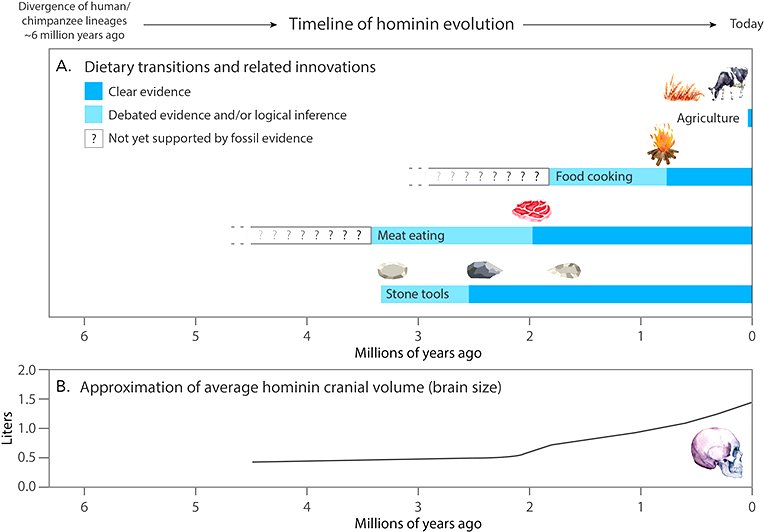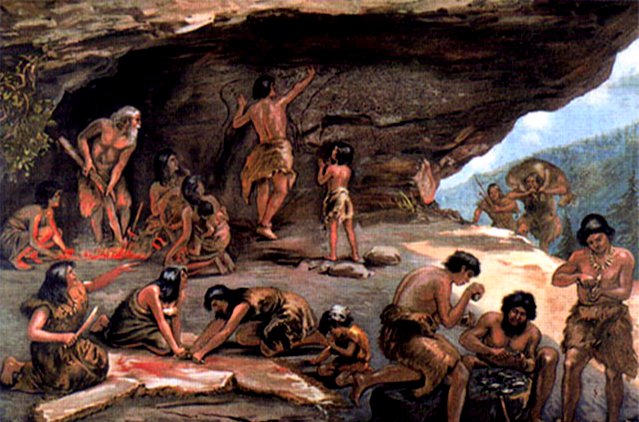As mortals, our highest aspiration should be to lead an existence that is attuned with nature - we seek to emulate the lifestyles and diets of past occupants of Earth who lived so many eons ago. One of the many questions that occupy our minds relates to the eating habits of early humans; was their diet vegetarian-based or animal-centric? Attractively captivating subject that promises to satisfy our desire for knowledge while providing deeper insight into the evolutionary path our predecessors forged before us. Since humans began eating foraging and hunting for sustenance during the Paleolithic era, their diet has undergone dramatic change. From Paleolithic times to Neolithic civilization, humans have experienced dramatic dietary transformation. But one fundamental question remains - did ancient Homo sapiens depend mainly on plant sources for sustenance, or did they indulge their meat-eating tendencies by hunting for sustenance? Early humans were generally omnivorous creatures who relied on whatever sources were accessible based on factors like habitat, time period and environmental considerations for sustenance. This expose will trace the path of human diet history, survey the diets of our early ancestors and seek to answer one lingering query - were early humans vegan or did they include animal products in their diets? For maximum SEO effect, this publication shall use both keywords "were early humans vegan?" and "evolution of human diet" when optimizing its SEO value.
I. The Evolution of Our Diet
Human history has seen our sustenance evolve drastically throughout human history. Two million years ago, our forebears relied on whatever fauna or flora they could gather for sustenance based on terrain conditions, climate changes, creatures found within their territory, climate conditions and what food sources existed at any one time; later as early humans adjusted to their surroundings more they gradually introduced different foods into their diet - leading them towards adaption by including all sorts of new items in their repertoire of foodstuffs - ultimately leading to modern-day diverse diets with ever expanding repertoires of choices!
Omnivorism among Early Humans
Anthropologists conducting studies on our predecessors' diet have unearthed evidence of omnivorism among early humans. They were adept at eating both animals and plants as sources of sustenance for survival and progression as a species; yet the quantity and quality of food consumption varied depending on geography and period.
The Paleoithic Period
The Paleolithic period, also referred to as "Old Stone Age," started over two million years ago and continued for another 10,000 years or so. Early humans lived as hunter-gatherers during this time period, feasting primarily on wild animals and plants from nature - lacking access to dairy products, grains, legumes or any form of processed food such as cheese. Their culinary preferences included different vegetables, fruits, seeds and nuts with meat being consumed to provide essential nutrition as well as fat and protein sources.
The Neolithic Era
Humanity first entered farming around 10,000 years ago during the Neolithic era or "New Stone Age." With this shift came widespread food production and animal husbandry that led to more massive eating patterns such as dairy products, grains and legumes being consumed as staple foods - providing carbohydrates and plant-based proteins besides meat for sustenance.
Environmental, resource availability and cultural and social influences all play a vital role in shaping our dietary choices, from their origin to today. Gaining more understanding about this history can assist us with making more informed decisions regarding diet. Over the next sections, we will delve deeper into early human Paleolithic and Neolithic habits while making use of an such as "evolution of human diet" for SEO optimization purposes.
II. The Paleolithic Era
Paleolithic humans relied heavily on food gathering and hunting as a primary means of sustenance for survival, with nomadic populations constantly moving around across landscapes searching for sustenance and shelter. Consumption was diverse and consisted of everything from wild game and fish to nuts, seeds, fruits and vegetables; consumption being dependent upon various variables like location and seasonality.
Meat Consumption
Meat consumption was an essential source of nutrition for primitive humans of the Paleolithic period, providing essential proteins, fats, vitamins, and minerals vital for their survival. Alongside meat consumption their diet included tubers and root vegetables which provided essential sources of vitamins, carbs, and fiber - providing an additional nutritional source.
Nuts and Seeds
Nuts were consumed regularly during the Paleolithic era. A source of both fat and protein, nuts were an easy, sustainable food source without spoilage risks. Seeds also played an essential part of primitive humans' diet, being ground into flour to make bread or blended into soups or stews for essential nutritional support.
Other Animal Products
Primitive humans did not consume dairy products, yet consumption of other animal products such as eggs remained part of their diet due to hunting and gathering activities. Furthermore, early humans also acquired nutrition through unusual sources, including insects, honey, or small birds.
Paleolithic humans consumed a diet designed to meet all essential nutritional needs necessary for their survival; however, this varied depending on location and environmental changes; nonetheless it was imperative for their survival as an indication of resilience and adaptability across a rapidly-evolving planet.
III. The Neolithic Era
Neolithic times marked a dramatic transformation in human sustenance. Our ancestors' food habits underwent dramatic change with farming and animal domestication becoming the norm, creating unprecedented food production on an unprecedented scale that still shapes humanity today.
Greatest Contributions of Neolithic Age Civilization to Human Diet
One of the greatest contributions of Neolithic age civilization was its introduction of grains to human diet. Wheat, barley and rice became staples quickly as humans consumed these nutritious sources of carbohydrates that provided essential energy sources. Furthermore, people began cultivating legumes as easily-cultivated sources of plant-based protein sources such as lentils and beans to supplement these dietary changes.
Dairy products were also given prominence during the Neolithic era. Humans learned how to domesticate cows, goats, and sheep and began enjoying their milk and dairy products as essential sources of calcium and other essential nutrients were added into their diet.
Yet despite these noteworthy dietary additions, meat continued to play an essential role during Neolithic times. Humans were blessed with access to domesticated animals like pigs, chickens, and cows as sources of meat that became an integral component of early humans' diets. Henceforth such animals served as significant nutritional sources that contributed significantly towards shaping early humans' diets.
Distinguishing Characteristics of Neolithic Diets
Neolithic diets distinguished themselves from Paleolithic ones by providing early humans with both plant- and animal-derived food sources that provided essential nutrition for survival and growth.
>Quote: "Plant-based vs Omnivorous"SEO Optimization
- Neolithic Age Civilization - LSI Keywords: human sustenance, food habits, farming, animal domestication
- Greatest Contributions of Neolithic Age Civilization to Human Diet - LSI Keywords: grains, wheat, barley, rice, legumes, plant-based protein
- Dairy products - LSI Keywords: cows, goats, sheep, milk, calcium, essential nutrients
- Meat - LSI Keywords: domesticated animals, pigs, chickens, cows, nutritional sources
- Distinguishing Characteristics of Neolithic Diets - LSI Keywords: plant-derived food sources, animal-derived food sources, essential nutrition, survival, growth
- Plant-based vs Omnivorous - LSI Keywords: diet, nutrition, food sources
IV. The Bottom Line
One of the more intriguing facets of human history is our early ancestors' diets. Research has demonstrated that their omnivorous diet consisted of both plant and animal-based food sources, depending on factors like geographical location and period.
At every stage in our evolution, our diet has grown increasingly diverse, offering us an abundance of tasty cuisine. But regardless of this change, incorporating more plant-based foods remains vitally important: eating fruits, vegetables, nuts and seeds provides essential vitamins, minerals and fiber needed for optimal health.
An effective diet should incorporate both plant- and animal-based foods. Eating meat, eggs, and dairy products helps ensure our diet includes essential protein, iron and vitamin B12 benefits as well as providing balance in terms of nutritional intake.
At its core, it is vitally important that individuals understand there is no "one-size-fits-all" approach to eating. Instead, we should pay attention to our bodies' individual requirements by choosing healthy food options from various sources to meet them and promote optimal health and well-being.
Importance of a Diverse Diet
A diverse diet is key to ensuring you're getting all the nutrients your body needs for optimal health. Incorporating various food sources, such as plant-based foods and animal-based foods, helps ensure that you're getting a balanced intake of vitamins, minerals, and other essential nutrients.
Early Human Diet
Historically, early humans followed an omnivorous diet that consisted of both plant and animal-based food sources. Depending on factors such as location and period, our early ancestors may have consumed more plant-based foods or more animal-based foods.
Dietary Patterns of Ancient Humans
Research has shown that the dietary patterns of ancient humans varied widely depending on the location and time period. However, the common thread among all early human diets was the inclusion of both plant and animal-based foods. This diversity helped ensure they obtained all the necessary nutrients for survival and optimal health.
>"Let food be thy medicine, and medicine be thy food." - HippocratesConclusion
At the end of the day, the most important thing to remember about your diet is that there's no one right way to eat. Instead, focus on incorporating a variety of healthy foods to meet your body's individual requirements and promote optimal health and wellness.
Were Our Early Human Forbears Vegans?
When considering this question, the results may shock. Analyzing Paleolithic and Neolithic epoch dietary practices shows clearly that our predecessors did not follow veganism but rather were omnivores who consumed whatever foods were available based on location and time period.
Paleolithic hunter-gatherers fed on an eclectic combination of meat, fish, fruits, vegetables, nuts, and seeds; during the Neolithic period however, thanks to agricultural techniques and animal husbandry they also included grains, legumes, dairy products as staple foods; however meat remained an indispensable staple of their meals.
Current debate surrounding veganism as opposed to an omnivorous diet has become contentious. Though veganism provides vital nutrients, one must strive to find an equilibrium between animal- and plant-based foods to meet all body nutritional requirements.
Overall, our early human predecessors did not advocate veganism and their eating patterns depended heavily on geographical location, available resources, and cultural milieu. Nowadays, however, we enjoy greater autonomy in making informed decisions regarding what we eat; adhering to a nutritionally well-rounded diet consisting of both plant-based and animal-based food will empower us all to lead healthier lives.




